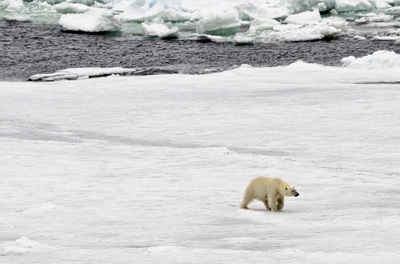Wednesday morning very early we arrived at the ice edge. It was still foggy but just before breakfast the sky cleared up and the sun made the scenery even more beautiful. It was impressive and strange at the same time; your gut instinct tells you that 'we should not just go straight ahead towards that massive ice floe' but apart from some vibrating and light shaking nothing happens when we do run over it. A 60 mm steel hull and a special design of the front of the ship makes this all possible.
The ice became thicker and thicker when we approached the northern edge of Zevernaya Zembla, the group of islands north of Cape Tjeljuskin near the Vilkitskiy Strait, the northernmost tip of the Eurasian continent. Since yesterday we follow a more or less straight line on 82 degree latitude going eastwards. We were standing on the deck after dinner with mouths open looking at how the 2 meter thick ice floes were being crushed like cookies. 'This is like a fire place but better' somebody said, 'it never gets boring to look at it!'. I totally agreed.
The ice became thicker and thicker when we approached the northern edge of Zevernaya Zembla, the group of islands north of Cape Tjeljuskin near the Vilkitskiy Strait, the northernmost tip of the Eurasian continent. Since yesterday we follow a more or less straight line on 82 degree latitude going eastwards. We were standing on the deck after dinner with mouths open looking at how the 2 meter thick ice floes were being crushed like cookies. 'This is like a fire place but better' somebody said, 'it never gets boring to look at it!'. I totally agreed.
Photo: Denis Chernykh
The wildlife here is pretty abundant. On the first day in the ice we already saw two polar bears. The first one was announced from the bridge "polar bear on starboard side, 700 m distance". It took its time to walk around the ship so everyone had a chance to look at it. The second one was sleeping on an ice floe and did not see us coming. Suddenly the "dirty snow" got up and starting running away, and we even had to slightly steer away from it to not completely crash the ice flow where it was on. There are also ivory gulls, black guillemots, dovekies, and shearwaters surrounding us. I have seen round and fatty seals lying in the sun on the ice, and the rumor goes that someone has even spotted a walrus. Science-wise, it is still a bit low key at the moment. The biogeochemistry, microbiology and sediment teams are enjoying the relative quietness before reaching our study area, but are busy preparing, fine-tuning and talking about logistics. The meteorologists onboard, however, are already releasing weather balloons four times a day, and people continuously measuring methane and carbondioxide in the water and air already have their systems up and running. In our key study area, the northern Laptev and East Siberian Sea, the station (sampling) frequency will be high and the workload pretty intense basically all the way to Alaska. Our ETA for arrival at the first station is early Monday morning, three more days to go!


 RSS Feed
RSS Feed
